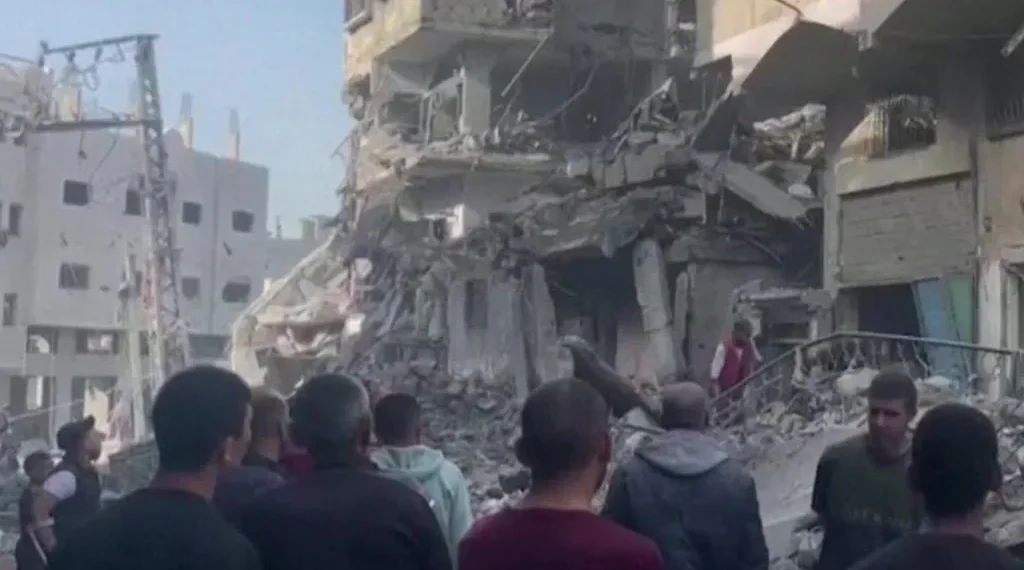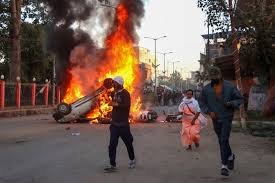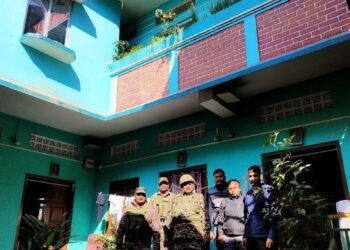The Israeli military claims it targeted Hamas and Islamic Jihad operatives embedded in civilian areas, but Gaza officials report massive civilian casualties, including the death of journalist Hassan Aslih and the destruction of the European Hospital’s ICU.
BY PC Bureau
May 17, 2025 – An Israeli airstrike struck multiple targets across the Gaza Strip on Saturday, killing at least 146 Palestinians, including women and children, according to Gaza’s Health Ministry. The bombardment, one of the deadliest in recent weeks, targeted residential areas, a hospital, and a school-turned-shelter, intensifying fears of a deepening humanitarian crisis in the besieged enclave.
The Israeli military claimed the strikes were aimed at Hamas and Islamic Jihad command centers, alleging that militants were operating from civilian infrastructure, including the European Hospital in Khan Younis and a school in Jabalia. “Our forces conducted precise operations to neutralize terrorist threats while taking steps to minimize civilian harm,” the Israel Defense Forces (IDF) said in a statement. However, Gaza health officials and eyewitnesses reported widespread devastation, with entire families buried under rubble and rescue teams struggling to reach victims.
The deadliest strike hit a densely populated neighborhood in Jabalia, where 92 people, including 34 children, were killed, according to local medics. Another attack on the European Hospital killed 16, including a prominent Palestinian journalist, Hassan Aslih, who was recovering from injuries sustained in a prior strike. The Gaza Health Ministry condemned the attack as a “deliberate targeting of medical facilities,” noting that the hospital’s intensive care unit was severely damaged, leaving critical patients without care.
ALSO READ: Horror Myanmar Children Face (2): Hundreds of Innocents Slaughtered
Eyewitnesses described scenes of chaos as Israeli warplanes dropped multiple bombs simultaneously. “The ground shook, and we heard screams everywhere,” said Ahmed al-Masri, a resident of Gaza City. “There was no warning, no time to escape.” Civil defense teams reported that many victims remained trapped under collapsed buildings, with limited equipment hampering rescue efforts.
The airstrikes come amid a renewed Israeli offensive following the collapse of a ceasefire in March. Israel’s campaign, launched in response to Hamas’s October 7, 2023, attack that killed 1,200 people and took 251 hostages, has killed over 53,000 Palestinians, according to Gaza authorities. The latest escalation follows Prime Minister Benjamin Netanyahu’s vow to “go in with full force” to dismantle Hamas and secure the release of remaining hostages, 24 of whom are believed to be alive.
Israeli Airstrikes Kill 146 in Gaza in 24 Hours, Health Officials Say pic.twitter.com/BuYdO4baPi
— Africalix (@Africa_lix) May 17, 2025
International outcry has grown over the mounting civilian toll and Israel’s blockade of Gaza, which has restricted food, fuel, and medical supplies since March 2. The United Nations warned that 290,000 children are at risk of starvation, with aid agencies reporting near-total depletion of food stocks. “The situation in Gaza is catastrophic,” said UN spokesperson Stéphane Dujarric. “Immediate action is needed to restore humanitarian access and protect civilians.”
The strikes coincided with U.S. President Donald Trump’s visit to the Middle East, raising questions about Washington’s role in mediating the conflict. While Trump has expressed support for Israel’s security, he has also called for a resolution to the hostage crisis. The U.S. State Department urged all parties to “exercise restraint” but stopped short of condemning the airstrikes.
READ: From Hope to Frustration: Inside the Kuki-Zo Decision to Halt Talks with Delhi
In Gaza, mourning families gathered at overwhelmed hospitals, where bodies lined morgues and corridors. “My sister, her children, all gone,” sobbed Mohammed Abed outside Al-Shifa Hospital. “Where is the world? Why is this allowed?” Protests erupted in the West Bank and East Jerusalem, with Palestinians demanding an end to the violence and international intervention.
Hamas denounced the airstrikes as a “genocidal massacre” and vowed retaliation, while Islamic Jihad fired two rockets toward southern Israel, causing no casualties. The Israeli military responded with further strikes, signaling no immediate end to the cycle of violence.
As night fell, Gaza remained under bombardment, with power outages and dwindling supplies exacerbating the crisis. The international community faces growing pressure to broker a ceasefire, but with both sides entrenched, the prospects for peace appear bleak.
Eyewitnesses described scenes of chaos as Israeli warplanes dropped multiple bombs simultaneously. “The ground shook, and we heard screams everywhere,” said Ahmed al-Masri, a resident of Gaza City. “There was no warning, no time to escape.” Civil defense teams reported that many victims remained trapped under collapsed buildings, with limited equipment hampering rescue efforts.
The airstrikes come amid a renewed Israeli offensive following the collapse of a ceasefire in March. Israel’s campaign, launched in response to Hamas’s October 7, 2023, attack that killed 1,200 people and took 251 hostages, has killed over 53,000 Palestinians, according to Gaza authorities. The latest escalation follows Prime Minister Benjamin Netanyahu’s vow to “go in with full force” to dismantle Hamas and secure the release of remaining hostages, 24 of whom are believed to be alive.
International outcry has grown over the mounting civilian toll and Israel’s blockade of Gaza, which has restricted food, fuel, and medical supplies since March 2. The United Nations warned that 290,000 children are at risk of starvation, with aid agencies reporting near-total depletion of food stocks. “The situation in Gaza is catastrophic,” said UN spokesperson Stéphane Dujarric. “Immediate action is needed to restore humanitarian access and protect civilians.”
The strikes coincided with U.S. President Donald Trump’s visit to the Middle East, raising questions about Washington’s role in mediating the conflict. While Trump has expressed support for Israel’s security, he has also called for a resolution to the hostage crisis. The U.S. State Department urged all parties to “exercise restraint” but stopped short of condemning the airstrikes.
In Gaza, mourning families gathered at overwhelmed hospitals, where bodies lined morgues and corridors. “My sister, her children, all gone,” sobbed Mohammed Abed outside Al-Shifa Hospital. “Where is the world? Why is this allowed?” Protests erupted in the West Bank and East Jerusalem, with Palestinians demanding an end to the violence and international intervention.
Hamas denounced the airstrikes as a “genocidal massacre” and vowed retaliation, while Islamic Jihad fired two rockets toward southern Israel, causing no casualties. The Israeli military responded with further strikes, signaling no immediate end to the cycle of violence.
As night fell, Gaza remained under bombardment, with power outages and dwindling supplies exacerbating the crisis. The international community faces growing pressure to broker a ceasefire, but with both sides entrenched, the prospects for peace appear bleak.












